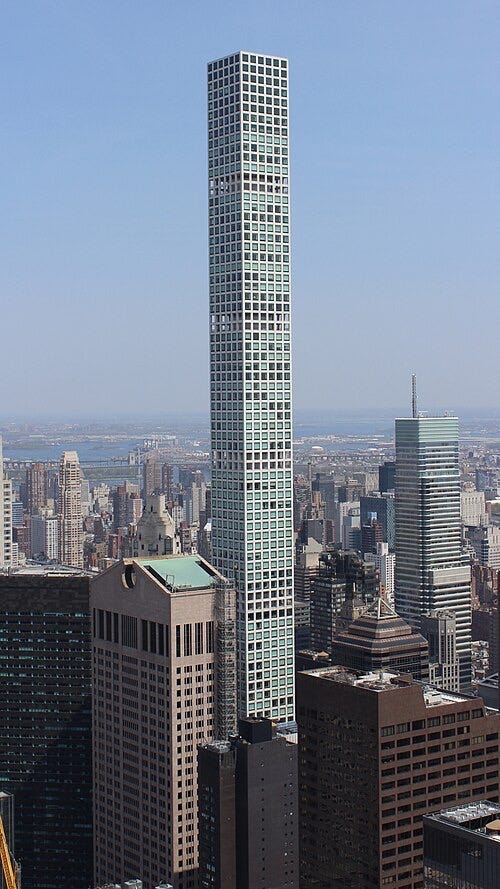432 Park Avenue

432 Park Avenue is one of the tallest and most recognizable residential skyscrapers in New York City. Finished in 2015, it made headlines for becoming the tallest residential building in the Western Hemisphere at the time — and for its super skinny, minimalist design.
We have written about this building previously, as an example of supertall buildings in New York. We are at it again since the alleged structural problems of 432 Park may be a harbinger of issues to come. Is there a limit to how high and slim residential towers can go?
In that post we discussed the idea of what a supertall building could be defined as:
According to The Council on Tall Buildings and Urban Habitat (CTBUH) in Chicago, a “Supertall” building is between 300 and 599 meters in height (984 - 1,965 feet). Before researching this post, I had no idea that a formal organization for defining supertall buildings existed. However, the fact that it is based in Chicago makes excellent historical sense.
Background
To determine “Supertall,” CTBUH currently uses the height guideline below to “measure” building heights:
Height is measured from the level of the lowest, significant, open-air, pedestrianentrance to the architectural top of the building, including spires, but not including antennae, signage, flag poles or other functional-technical equipment.
Given this standard, let's continue with 432 Park Avenue:
A first point to make is the demographic profile of the buyers. These units were priced from a few million up to 90 million, thus insuring an uber wealthy group of potential litigants if things were to go wrong.
Situated in Midtown Manhattan, the peoject sits on the site of what was the Drake Hotel. Harry Macklowe, the developer of 432, had purchased the Drake in 2006. New York has always been the place where competition to be the grandest and especially tallest buildings was the most intense. Developer Macklowe selected the Uruguayan architect Rafael Viñoly. According to the late architects website:
432 Park Avenue is an expression of the extraordinary qualities of the Manhattan grid and its design exploits these parameters. A regular grid of exposed concrete members creates an open basket within which seven “independent buildings” stack up, separated by spaces within which the building cores are exposed to the outdoor elements. These breaks allow for deflection of wind pressure.
The visually impressive image of the building facade grid is said to have been inspired by a trash receptacle designed by Josef Hoffmann, as shown below.
As discussed in our prior post, All supertalls are engineering marvels. In this case, the extraordinary width-to-height ratio necessitated a Tuned Mass Damper (TMD) to mitigate the structure's movement. The TMD became somewhat famous when a building in Taiwan left the device exposed, as shown below in yellow. A TMD is essentially a pendulum that swings to offset the movement of the building.
The extent of the issues in play for 433, are according to the New York Post:
When it comes to 432 Park Ave., one of Manhattan’s most expensive addresses, the cracks aren’t just in the concrete — they’re in the trust. The board at the famed Billionaires’ Row supertall is accusing its developers of orchestrating a “deliberate and far-reaching fraud” by concealing thousands of defects, many of which they claim compromise the building’s structure and safety, according to the New York Times. In two lawsuits — one filed in 2021, the other in April 2025 — unit owners allege a cover-up that spans nearly a decade and hundreds of millions of dollars.
To be thorough, 432 Park had some issues quite a while ago. Construction began in 2012 and at the time this was the slimmest skyscraper ever planned. New York City took the rare step of actually issuing a stop-work order. The New York Times reported in June of 2015
Construction work was briefly halted at 432 Park Avenue in Midtown Manhattan this week after a section of guardrail fell from a hoist near the top of the building, which is arguably the tallest in New York City. On Thursday evening, a day after the stop-work order was imposed, construction was allowed to restart after the problem with the hoist was resolved, a spokesman for the city’s Department of Buildings said.
This is not a regular occurrence in the world of Manhattan construction. As we mentioned above, the target buyer for the developer of the building was the Uber wealthy. Which is fine until their financial resources turn against you in litigation. Last month CNN reported:
Apartment owners at a luxury New York skyscraper are suing the building’s developers over a “far-reaching fraud” in which they allegedly hid structurally significant defects — including “thousands” of severe cracks on the tower’s facade.
The condo board at 432 Park Avenue, a super-skinny high-rise on Manhattan’s Billionaire’s Row, claims that real estate firm CIM Group failed to disclose the extent of damage that has resulted in flooding and impacted the value of their multimillion-dollar properties.
But owners and residents have since complained of numerous construction issues, including more than 20 water leaks since 2017, according to the complaint. In 2021, the condo board filed a lawsuit alleging a range of defects, from malfunctioning elevators and poor energy efficiency to a trash chute that sounds “like a bomb” when used.
In summary
Given the extraordinary prices that developers must pay to acquire parcels of land in prestigious urban settings globally, it is perfectly understandable that there is a necessity to maximize the number of units that can be sold or rented. And the onky way to go is up. The time honored economic rules require that a building like 432 Park must be built higher and faster. While these economic realities are virtually indisputable, there are the tangential questions of how high, how slim, and how fast. Perhaps this high profile litigation will inform the rules of the road going forward?





